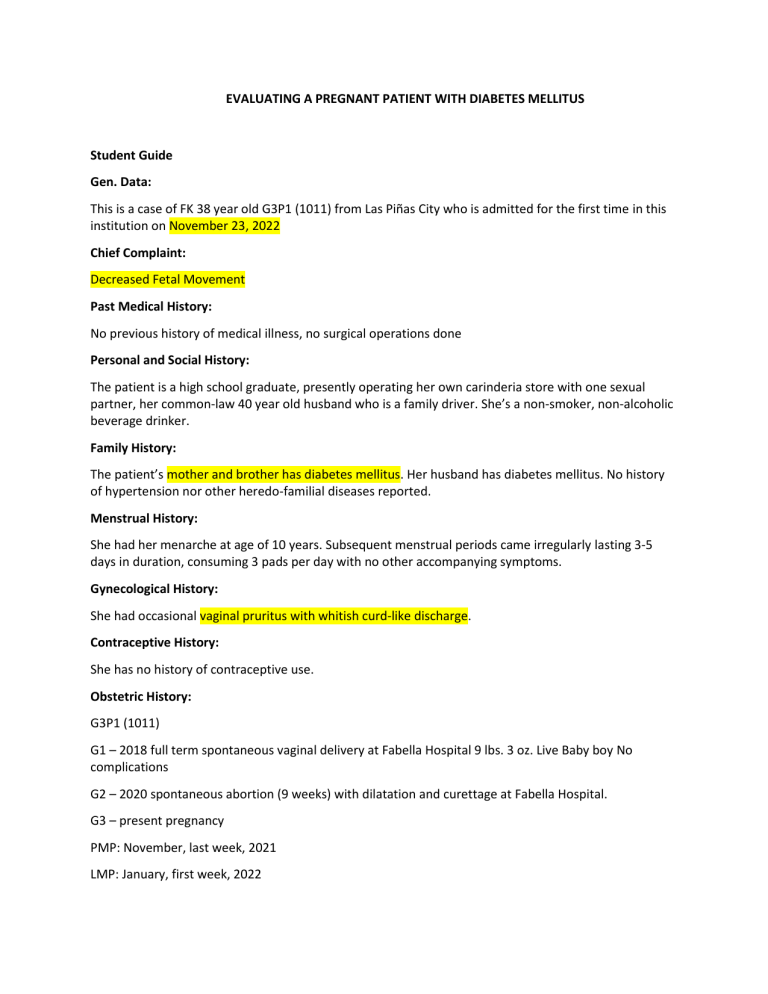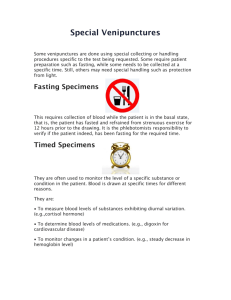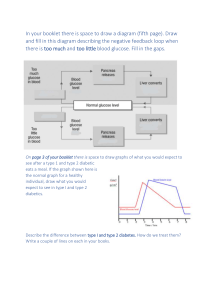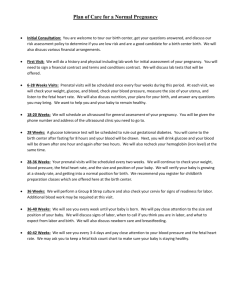
EVALUATING A PREGNANT PATIENT WITH DIABETES MELLITUS Student Guide Gen. Data: This is a case of FK 38 year old G3P1 (1011) from Las Piñas City who is admitted for the first time in this institution on November 23, 2022 Chief Complaint: Decreased Fetal Movement Past Medical History: No previous history of medical illness, no surgical operations done Personal and Social History: The patient is a high school graduate, presently operating her own carinderia store with one sexual partner, her common-law 40 year old husband who is a family driver. She’s a non-smoker, non-alcoholic beverage drinker. Family History: The patient’s mother and brother has diabetes mellitus. Her husband has diabetes mellitus. No history of hypertension nor other heredo-familial diseases reported. Menstrual History: She had her menarche at age of 10 years. Subsequent menstrual periods came irregularly lasting 3-5 days in duration, consuming 3 pads per day with no other accompanying symptoms. Gynecological History: She had occasional vaginal pruritus with whitish curd-like discharge. Contraceptive History: She has no history of contraceptive use. Obstetric History: G3P1 (1011) G1 – 2018 full term spontaneous vaginal delivery at Fabella Hospital 9 lbs. 3 oz. Live Baby boy No complications G2 – 2020 spontaneous abortion (9 weeks) with dilatation and curettage at Fabella Hospital. G3 – present pregnancy PMP: November, last week, 2021 LMP: January, first week, 2022 AOG by LMP: ? EDC by LMP: ? Antenatal History: The patient had a total of 5 prenatal check up at the JONELTA clinic. She first sought consultation at the JONELTA clinic when she started perceiving fetal movement at around the end of July 2022. She did not suspect that she was pregnant earlier because of her irregular menstruation. On first consultation: BP=120/80, HR=80 bpm, T=36.2° C, BMI= 35 FU=14 cm FHT: 140bpm. She was advised to have CBC, urinalysis, HbsAg, Vdrl which were all normal. Random blood sugar was 240mg/dl. She had a pelvic ultrasound on August 15 2022 which revealed: Single, Live, Intrauterine pregnancy, 24 1/7 weeks AOG by average biometry, breech presentation, normohydramnios, anterior placenta, grade 2. She was advised diabetic diet, exercise, self-monitoring blood glucose, insulin treatment and fetal kick count. On ff-up 2 hour postprandial blood sugar ranged from 180- 200mg/dl. She was not able to comply with her diet, exercise, and insulin treatment diligently. Repeat ultrasound on October 10, 2022 biophysical profile showed: Single, Live, Intrauterine pregnancy, 32 4/7 weeks AOG by average biometry (large for gestational age), cephalic presentation, normohydramnios, anterior placenta, grade 2, bps 8/8. She was advised again to adhere to her treatment regimen strictly and to do fetal kick count. Biophysical profile was requested every week alternating with non-stress test. On October 28, 2022, repeat ultrasound with BPS showed: Single, Live, Intrauterine pregnancy, 34 3/7 weeks AOG by average biometry (large for gestational age), cephalic presentation, normohydramnios, anterior placenta, grade 2 with BPS 8/8. Estimated Fetal Weight was large for gestational age. Her FBS ranged from 120-140mg/dl, 2 hour post prandial blood sugar ranged 180-250 mg/dl. She was still not compliant with her diet, exercise, and insulin injection. She was subsequently lost to follow-up until a few hours prior to admission when she perceived decreased fetal movement. REVIEW OF SYSTEMS CNS: no dizziness, no blurring of vision CVS: no chest pain, no easy fatigability Resp: no dyspnea, no cough, no colds GIT: no nausea, no vomiting, no epigastric pain, (+) polyphagia, (+) polydipsia GUT: no dysuria, no urgency, no frequency, (+) polyuria Musculo-Skeletal: no myalgia, no arthralgia Hema: no bleeding tendency PHYSICAL EXAMINATION General Survey: Patient is awake, coherent, not in cardio-respiratory distress Vital Signs: BP=120/80 HR=85bpm RR=28 T=36.8°C BMI=40 HEENT: Pink palpebral conjunctivae, anicteric sclerae Chest & Lungs: Symmetrical chest expansion, clear breath sounds Heart: Adynamic precordium, normal rhythm and rate Abdomen: globular, No contraction noted FU = 40cms. FHT = not appreciated EFW = 4000grams LM1 = Breech LM2 = Fetal back right, Fetal small parts left LM3 = cephalic LM4 = not engaged Inspection: Normal external genitalia, no gross pooling of fluid in the vagina, (+) curd-like discharge cervix 1-2 cm dilated, beginning effacement, station (-) 3, normal clinical pelvimetry. Extremities: Full and equal pulses, grade 2 edema. Guide Questions: 1. Calculate the AOG and EDC by LMP. Calculate the AOG and EDC by transvaginal ultrasound? What is your admitting impression? AOG AND EDC BY LMP January (1) 30 February 28 March 31 April 30 May 31 June 30 July 31 August 31 September 30 October 31 November (23) 23 Total 326 326 days/7= 46 4/7 weeks age of gestation by LMP 01/01/2022 -3 +7 EDC: 10/08/2022 AOG AND EDC BY TVS August (15) 16 100 days/7= 14 2/7 weeks + 24 1/7 weeks = 38 3/7 weeks September 30 age of gestation by UTZ October 31 November (23) 23 02/27/2022 -3 +7 EDC: 12/04/2022 Total 100 2. What is the risk of this patient having diabetes mellitus in pregnancy? Age >30 years old due to the combined effects of increasing insulin resistance and impaired pancreatic islet function with aging. Computed body mass index is 40 and classified as obese class III Family history: mother and brother has diabetes mellitus Gynecological history: occasional vaginal pruritus with whitish curd-like discharge o When blood sugar levels are high, the body starts to get rid of excess sugar through bodily fluids, including vaginal secretions. Yeast gets its energy from sugar, so the vaginal environment makes it easy for yeast to multiply, overgrow, and turn into a yeast infection. o High blood sugar also interferes with immune system functions (the body's defense system) that help fight off yeast infections. This means uncontrolled diabetes can make it more difficult to prevent and get rid of a vaginal yeast infection Obstetric history - History of delivering a macrosomic baby from her previous pregnancy. o Higher amount of blood glucose passes through the placenta into the fetal circulation. As a result, extra glucose in the fetus is stored as body fat causing macrosomia, which is also called 'large for gestational age' [Type here] o Macrosomia increases the risk of shoulder dystocia, clavicle fractures and brachial plexus injury and increases the rate of admissions to the neonatal intensive care unit. o For the mother, the risks associated with macrosomia are cesarean delivery, postpartum hemorrhage and vaginal lacerations. Previous delivery of macrosomic baby, Previous spontaneous abortion FBS, RBS and 2-hr postprandial blood sugar are beyond normal range Review of systems revealed patient experiencing the 3 P’s, polyphagia, polydipsia, and polyuria. o These findings are seen in cases of diabetes mellitus. Patient has a BMI of 40 which is classified as Obese Class II Present pregnancy shows FH of 40cm and EFW of 4000grams which Is beyong the normal range Upon physical examination, there is a curd-like discharge suggestive of yeast infection which is common in people with excess glucose, seen in this patient. Extremities revealed grade 2 edema which may indicate kidney damage secondary to hyperglycemia 3. On initial consultation, what diagnostic examinations will you request for? Complete Blood Count Urinalysis Blood Typing VDRL, HbsAg, HIV1/HI2 Transvaginal and transabdominal Ultrasound FBS/HbA1C/RBS Screening for GDM should be done: • In Filipino Gravidas with no other risk factors and normal FBS/HbA1C/RBS results, screening will be done at 24-28 weeks AOGvia 2 hour 75 grams OGTT o If OGTT results are normal, the next OGTT test will be done at 32 weeks or earlier if the patient and fetus present with symptoms of hyperglycemia. o Criteria using 75g OGTT Fasting blood glucose: >92 mg/dL 1-hour OGTT: 180 mg/dL 2-hour OGTT: >153 mg/dL [Type here] [Type here] • In Filipino Gravidas who presents with risk factors for GDM should immediately be tested with 2-hour 75g OGTT at first consult o Criteria for Overt DM Fasting blood glucose: >126 mg/dL (7 mmol/L) HbA1c > 6.5% RBS > 200 mg/dL (11.1 mmol/L) + symptoms of hyperglycemia 2 hours 75g OGTT >200 mg/dL (11.1 mmol/L) 4. What is the maternal antepartum management for diabetes mellitus in this patient? FIRST TRIMESTER o Achieve euglycemic state with proper DM diet, physical activity and medications for diabetes. o Multiple daily injections of insulin than oral hypoglycemics o Total caloric intake 30-35 kcal/kg with low glycemic food index o 3 meals, 3 snacks, 30% Carbohydrates, 40% Fat, 20% Protein o 4 point CBG monitoring of blood glucose SECOND TRIMESTER o Maternal Serum AFP determination to detect neural tube defects and anomalies at 16-20 wks THIRD TRIMESTER o Continuous fetal monitoring and surveillance: o Fetal heart rate monitoring o Biophysical profile o Contraction stress test o Fetal movement count 5. What are the effects of Diabetes Mellitus on the developing fetus? Spontaneous abortion Malformation s [Type here] Poor glycemic control has been found to be associated with early miscarriage. (Initial HbA1C > 12% or with persistent pre-prandial glucose concentrations> 120 mg/dL) Incidence of major malformations are doubled in cases of pregnant women with diabetes mellitus (Type 1). Moreover, cardiovascular malformations account for more than half (4x) of the anomalies detected in such cases this is due to poor control preconceptually or in early pregnancy [Type here] Fetal overgrowth is more commonly seen in pregestational diabetes Altered fetal patients. Maternal hyperglycemia prompts fetal hyperinsulinemia. This in turn stimulated excessive somatic growth. However, the brain may not be growth as affected. Overt diabetes has been known to be a risk factor for preterm delivery, Preterm owing it to the Delivery medical and obstetrical complications that come with hyperglycemia. The risk of fetal death is 3-4 times higher in women with overt diabetes mellitus. Such cases of fetal demise are “unexplained” because common factors like placental insufficiency, placental abruption, IUGR, or Unexplained oligohydramnios are not identified. These stillbirths are thought to result fetal demise from poor glycemic control and maternal ketoacidosis. Fetuses are typically large for gestational age and expire late in the pregnancy, particularly before labor or at the third trimester. diabetic pregnancies are often complicated by the presence of excess amniotic fluid Hydramnios (polyhydramnios >24cm). This can be defined as an AFI of >24 by the third trimester. Note that increase in AFI parallels glucose level in amniotic fluid. 6. What are the effects of pregnancy of the Maternal Diabetes Mellitus? Diabetic nephropathy This is the common complication which most often forces preterm delivery in a diabetic pregnant patient. Special risk factors: any vascular complication and preexisting proteinuria, with or without chronic hypertension This is considered as the leading cause of end-stage renal disease. Clinically detectablenephropathy starts with microalbuminuria > 300mg/24hr. Diabetic retinopathy This is the most important cause of visual impairment in patients < 60 years of age, and it is worsened by pregnancy Diabetic neuropathy This pertains to diabetic gastropathy in pregnant women brought about by peripheral symmetrical sensorimotor diabetic neuropathy. It causes nausea and vomiting, nutritional problems and difficulty with glucose control. Preeclampsia [Type here] [Type here] Diabetic ketoacidosis Infections This is most often encountered in women with type 1 diabetes. It may develop with hyperemesis gravidarum, infection, insulin noncompliance, Bmimetic drugs given for tocolysis, and corticosteroids administration. Pregnant woman usually develops ketoacidosis at lower blood glucose thresholds than when nonpregnant DKA Infection rates are higher in diabetic patients. Common diseases include candida vulvovaginitis, urinary and respiratory tract infections, and puerperal pelvic sepsis 7. What is the ideal antenatal surveillance for this developing fetus? Ultrasonogram to assess fetal size every 4-6 weeks from 26 to 36 weeks Fetal monitoring and surveillance 16-20 weeks, maternal AFP determination to detect neural tube defects and anomalies by UTZ. 32-34 weeks, testing for fetal movement counting, fetal heart rate monitong, biophysical profile evaluation 2x a week, and contraction stress test. 8. What are the expected neonatal complications in the event this fetus survives? Hypoglycemia – caused by hyperplasia of the fetal Bislet cells brought about by maternal hyperglycemia Hypocalcemia – metabolic derangement in neonates of diabetic mothers Hyperbiliribunemia and Polycythemia – fetal response to hypoxia brought about by hyperglycemia-mediated elevation in maternal affinity for oxygen and getal oxygen consumption Cardiomyopathy – ventricular hypertrophy due to hyperinsulinemia 9. What is the ideal route of delivery and anesthesia for this pregnancy? The ideal route of delivery for this patient is through cesarean delivery. This is to avoid a possible traumatic birth of a large fetus in the mother and since vulvovaginal candidiasis is being considered, this may prevent the vertical transmission of infection to the fetus Regional anesthesia will be given. Either spinal or epidural anesthesia may be appropriate for the patient, provided that maternal glycemic control is [Type here] [Type here] satisfactory, the patient receives aggressive preanesthetic volume expansion with a non-dextrose containingbalanced salt solution and hypotension is treated aggressively with ephedrine 10. What is the postpartum management for this pregnancy? POST-DELIVERY • Persistent hyperglycemia in early puerperium is uncommon and can be excluded → Fasting or random capillary blood glucose levels before discharge • Elevated values should be confirmed with fasting plasma glucose (>126 mg/dL or 7.0 mmol/L) or postprandial glucose (>200mg/dL or 11.1 mmol/L) • Pharmacologic therapy should be continued to maintain good glycemic control and provide sufficient calories for lactation &infant well-being • All types of insulin, glyburide or glipizide can be safely used by breastfeeding women. POSTPARTUM PERIOD • The Fifth International Workshop Conference on Gestational Diabetes recommended that women diagnosed with gestationaldiabetes undergo evaluation with a 75-g oral glucose tolerance test at 6 to 12 weeks postpartum and other intervals thereafter. The following are the recommendations o Post delivery (1-3 days) Fasting or Random Plasma Glucose To detect persistent; overt diabetes o Early post partum (6-12 week); 75-g, 2-hr OGTT Postpartum classification of glucose metabolism o 1-yr postpartum; 75-g, 2-hr OGTT Assess glucose metabolism o Annually; Fasting plasma glucose Assess glucose metabolism Triannually; 75-g, 2-hr OGTT Assess glucose metabolism o Pre Pregnancy; 75-g, 2-hr OGTT Classify glucose metabolism Strict proper diet modification and exercise programs for the patient to follow. o • COUNSELLING • Counselling about birth control and family planning. Effective contraception is a must [Type here] [Type here] • in order to properly plan out and manage succeeding conceptions in the future. Educate the patient on the importance of diet modifications and exercise programs since there was difficulty in adhering to the recommendations antenatally. [Type here]





